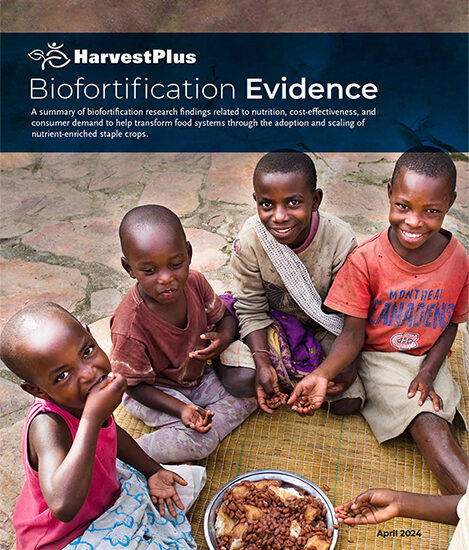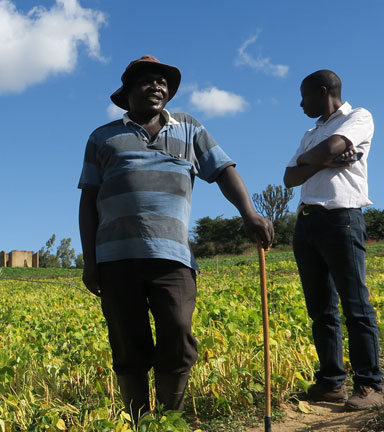This page highlights notable research related to biofortification. For an explanation of the types of research that inform the biofortification evidence base, visit the Marshalling Evidence page.

Biofortification Research Evidence Brief
A summary of nutrition, health, and socio-economic research findings about biofortified crops.
READ MORE
Assessing the Adoption and Production of Iron Beans in Zimbabwe
A nationally representative study was conducted in Zimbabwe to establish the adoption rate of biofortified beans in the country.
READ MOREFeatured Research
Rice Biofortification: Approaches to Enhance Grain Iron and Zinc Content | Crop Development Research
Publication: Frontiers in Plant Science Summary: Thirty-seven biofortified rice varieties are available for commercial cultivation, 29 rich in zinc. The Indian Agricultural Research Institute revised the levels of zinc in polished rice to 24 mg/kg (85% of the breeding target). Zinc rice can provide up to 60% of daily zinc needs and help reduce zinc deficiency in countries where rice is a staple such as Bangladesh, Indonesia, Philippines, and India. Tools and opportunities for the development of nutri-dense rice varieties are discussed.
Agronomically Biofortifying Crops to Alleviate Malnutrition | Crop Development Research
Publication: Millets – Rediscover Ancient Grains | Summary: Farmers and crop producers can nutritionally enhance food crops like millets and sorghum by applying nutrients directly on plants during the growing process using micronutrient fertilizers. By improving the nutritional status of crops, it can improve the nutritional status of humans who eat those crops—a proven strategy for combatting micronutrient deficiencies.
Future Directions for Millet Biofortification | Crop Development Research
Publication: Frontiers in Plant Science | Summary: A review of recent genetic and genomic innovations that can be explored to enhance grain micronutrient density in millets, a food key source for people living in dryland tropics and drought-prone areas of South Asia and sub-Saharan Africa.
Yield and Agronomic Performance of Provitamin A Maize: DR Congo | Crop Development Research
Publication: Open Agriculture | Summary: To promote crop improvement and adoption of improved varieties by farmers, maize genotypes were evaluated and recommendations made for high performing varieties that will contribute to improved food and nutritional status in children in the South-East of the DR Congo.
Biofortification to Avoid Malnutrition Amid a Changing Climate | Climate Research
Publication: Frontiers in Plant Science | Summary: Increasing temperatures and CO2 levels affect global crop productivity, resilience, and nutrition. This review explores crop breeding techniques to enhance micronutrient bioavailability in seed, tuber, and storage roots. Nutrient uptakes in plants, the distribution of nutrients in the edible parts of crops, the molecular basis of nutrient transport and absorption in humans, and the achievements of breeding nutrient-dense crops are discussed.
Wheat Biofortification to Alleviate Malnutrition | Nutrition Research
Publication: Frontiers in Nutrition | Summary: An editorial for a special issue on the role of nutrient-enriched wheat in nutritious and sustainable food systems that combat micronutrient deficiencies. The special issue includes an update on recent progress made on biofortification and the latest approaches to increase wheat micronutrient content.
Archive
Climatic Impacts on Food Systems, Diet Quality, Nutrition and Health Outcomes
Projected Increase in Acute Food Insecurity Due to War in Ukraine
Malawi: Nationally Representative Estimates of the Cost of Adequate Diets and Policy Options
Identification of Candidate Genes Regulating Drought Tolerance in Pearl Millet
Addressing Gender Norms to Address Financial Inclusion
Impacts of Digital Financial Services on Women’s Economic Empowerment
Blood, Behavior, and Brain Function: Impacts of Iron Biofortification
Genomic selection can accelerate the biofortification of spring wheat
High-resolution genome-wide association study pinpoints metal transporter and chelator genes involved in the genetic control of element levels in maize grain
Use of stable isotopes to study bioconversion and bioefficacy of provitamin A carotenoids
Applying Zinc Nutrient Reference Values as Proposed by Different Authorities Results in Large Differences in the Estimated Prevalence of Inadequate Zinc Intake by Young Children and Women and in Cameroon
The halo effect of biofortification claims on taste inference and purchase intention
There is a nutrition-related health crisis in the United Kingdom
New Study Shows Eating Biofortified Cassava Improves Vitamin A Status In Nigerian Children
Zinc Study Indicates Possible Role for Biofortification In Addressing Non-Communicable Diseases
Study Shows Biofortified Maize Improves Vitamin A Content of Breast Milk
Study Finds That More Nutritious Pearl Millet Can Meet Full Iron Needs of Children
Study: Foods Made With Whole-Grain Zinc Maize Lose Only Small Share of Zinc in Processing, Cooking
New Research Shows Benefits of Iron-Biofortified Pearl Millet for Physical Activity in Adolescents
Transition From Targeted Breeding to Mainstreaming of Biofortification Traits in Improvement Programs